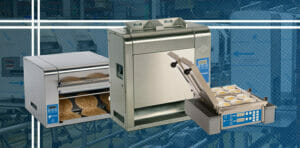Before a product is delivered to our customers, it starts as a concept with the product development team. Tasked with creating the equipment solutions that meet our customers’ needs, they bring a combination of innovation, experience and order to each project.
Here, Cheri Panasik, PhD, VP of Engineering & Product Development and Bhupendra Patel, Director of Engineering answer questions about Antunes’ product development team and how every step of their process has the customer top of mind.
How Are You Able to Keep Your Finger on the Pulse of the Latest Foodservice Trends?
We keep up with trends in a variety of ways:
- Attending trade shows & conventions such as NAFEM, NRA and McDonald’s Worldwide
- Reading industry publications
- Participating in NAFEM technical committees, which offer a platform to weigh in on and influence constantly evolving industry standards
- Reviewing new patents — both inside and outside of the foodservice industry — to identify new technology that has a potential application that could benefit Antunes equipment
What Other Teams Are Involved in the Product Development Process and How Do You Work Together?
Almost every department at Antunes plays a role in the product development process — from sales and marketing to operations, engineering and fabrication.
Even departments that may not be directly involved in product development can provide key insights. In one instance, we were designing a product and we were not aware that it would be difficult for the customer to remove the unit from a shipping box. During collaboration with shipping and the cross-functional team, the team informed us that a handle would facilitate customer removal of the unit from the shipping box.
Another department that we make sure we involve is technical service because they have visibility to how the piece of equipment will be serviced. For example, we’ve made adjustments to a design after their team pointed out that it would require too much time to change one of the consumables.
As part of the review and brainstorming process, team members will actually ask “how does that make our customer be successful?” to validate a feature or design decision. We want to gather this input on the front end to help ensure that we’re creating equipment that truly makes our customers successful.
How Do You Identify Product Gaps in the Marketplace and What Are You Currently Seeing as Opportunities?
In addition to conducting market research, reviewing menu trends and conversing with customers and potential customers, benchmarking is a key tool for identifying product gaps.
We look at equipment from both competitors and non-competitors in the foodservice industry to make sure that we’re taking into consideration all possible opportunities.
We purchase competitors’ used equipment to be able to benchmark what is really robust, what might be wearing out prematurely and what might be a customer pain point and use these insights to inform our product development process.
We also conduct a similar review with Antunes equipment both as part of the equipment testing process and in order to gain additional insights from the technical service team as they interact with equipment that has been in the field.
Currently, we know that labor issues continue to impact restaurant operations, and automation in the back-of-the-house may alleviate some of those concerns. Operators are looking to increase efficiencies — both in terms of energy usage and speed of service — and equipment plays a key role in addressing these needs.
How Can Customers Help in the Product Development Process?
One idea that comes to mind is providing an accurate description of the product requirements from the onset of the project.
Consider the end results of these two requests:
“I need heated display case that fits these dimensions, is made of glass and has two shelves.” or “I need heated display case that fits these dimensions, is made of glass and has two shelves. The unit also needs to have both front and back doors. I would like lighting, so that customers can see the food easier, and air flow is an important consideration for me.”
Which description will yield a more accurate prototype? The second one with greater detail.
As part of the product development process, we make sure we are asking the right questions to get the customer thinking about their specific application and to better inform our team, which can accelerate the product design, review and testing process.
What Are Your Favorite Types of Product Development Projects to Work On?
We get excited about developing equipment that brings added value to our customers. Recently, we’ve worked on the Egg Station with Dual Zone, which provides a way to consistently and quickly cook eggs for increased breakfast capacity at QSRs, and the Flat Bread Toaster which represents a new application for our toasting technology in an innovative product category.
Want to hear more answers from the Antunes team? Read this Q&A about our in-house repair program.


 Antunes Showcasing New Countertop Cooking Solutions at PIR Exhibition in Moscow
Antunes Showcasing New Countertop Cooking Solutions at PIR Exhibition in Moscow